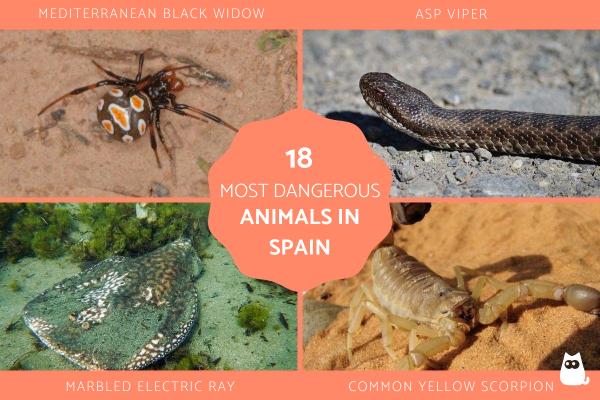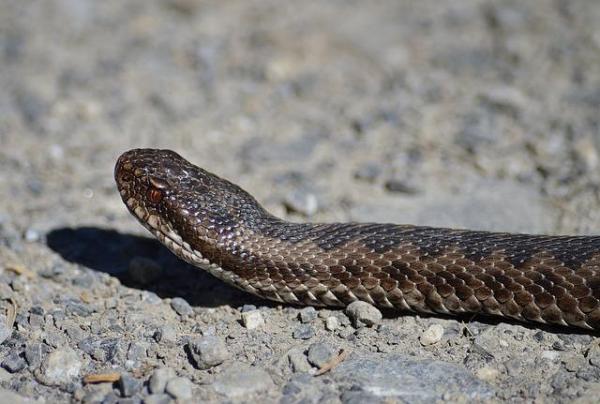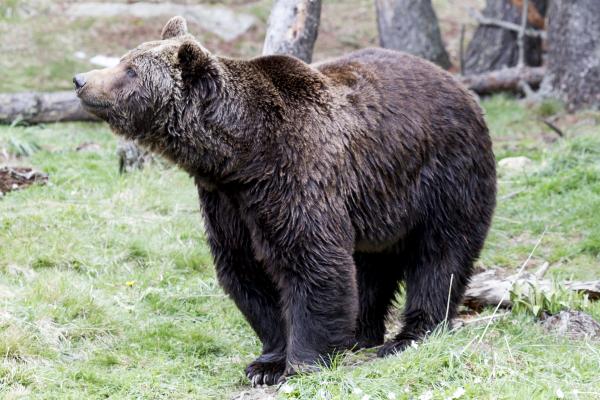The Most Dangerous Animals in Spain


Spain is a country which is known for its sunny beaches, beautiful mountain ranges and Mediterranean climate. However, the climactic diversity of the country is great. With regional climates and seasonal variations, the flora and fauna of this country are equally diverse. While we may not think of Spain as having very dangerous animals, there are definitely some creatures from which we want to keep our distance.
Although fatalities from wild animals in Spain are very rare, this is partly because we know to respect wild nature. AnimalWised reveals the 18 most dangerous animals in Spain to help you know when exercising caution is imperative. We reveal facts about their habitats and behaviors, as well as photos of these dangerous Spanish animals in case you come across any of them.
- Asp viper (Vipera aspis)
- Lataste's viper (Vipera latasti)
- Marbled electric ray (Torpedo marmorata)
- Mediterranean black widow (Latrodectus tredecimguttatus)
- Yellow sac spider (Cheiracanthium punctorium)
- Common yellow scorpion (Buthus occitanus)
- Tiger mosquito (Aedes albopictus)
- Brown bear (Ursus arctos)
- Portuguese man o' war (Physalia physalis)
- Greater weever (Trachinus draco)
- Other dangerous animals in Spain
Asp viper (Vipera aspis)
Often known simply as an asp, the asp viper has a habitat range that spreads over the north of Spain and over large swathes of some neighboring European countries. They can reach a maximum of 33" (85 cm) in males, although females are shorter and thicker. It is very adaptive to a range of ecosystems.
Although it is only present in the north of Spain, the asp viper is widespread across Italy. The asp has one of the most potent snake venoms in Europe. Fatalities from asp bites are rare, but they can occur if the bite is left untreated. It is this venom which makes the asp viper one of the most dangerous animals in Spain.
Discover whether there are venomous snakes in the UK with our related guide.

Lataste's viper (Vipera latasti)
Also known as the snub-nosed viper, the Lataste's viper is also a dangerous Spanish animal thanks to its venom. It is distributed throughout much of the Iberian peninsula, as well as parts of North Africa. However, the snub-nosed viper and its four subspecies are considered vulnerable in terms of population numbers. They have a special preference for humid, rocky habitats, dry forests and scrublands, but it can also be found near coastal dunes
This usually measures less than 28.3" (72 cm). They have a yellow tip on their tail which may be used to lure prey, especially if they stick it out of the rocks under which they normally hide. Although it can bite, this viper is not usually aggressive towards people unless frightened. Although not as toxic as asp viper venom, immediate treatment is necessary to avoid complications.
The Lataste's viper is relatively safe, but you can learn about some much more dangerous reptiles with our guide to the types of taipan snakes.

Marbled electric ray (Torpedo marmorata)
So far we have seen the most dangerous animals in terrestrial Spain, but the waters of this Mediterranean country are also home to some threatening animal species. The marbled electric ray is a cartilaginous fish that inhabits various coastal regions of Spain. It lives in sandy seabeds, seagrasses and coral reefs. Females are larger than males, making them sexually dimorphic. Although rare, they can reach as long as 3.2 ft (1 m).
The marbled electric ray is not a stingray, so it cannot sting. However, it is able to produce enough electricity to provide a nasty electric shock. This is very useful in repelling potential predators, but it is also used against any curious swimmers who get too close. The shocks are not usually sufficient to kill on their own, but they can disorientate and lead to drowning in some cases.

Mediterranean black widow (Latrodectus tredecimguttatus)
Many of us most associate black widow spiders as being from areas like Australia, but they have a very wide distribution depending on their species. They are characterized by their fearsome markings, sexual cannibalism of the male by the female and venom. They mainly inhabit agricultural areas, meaning that farm workers are the demographic who most receive bites from the Mediterranean black widow spider.
In general, the Mediterranean black widow appearance is similar to that of other spiders in the group. It is distinguished by spots on its back that can be red, yellow or orange. Females are larger than males, measuring up to about 15 mm. The males are half this size. Although it does not usually interact with humans, its bite is extremely painful. It is not usually fatal, but it does cause certain problems for the victim.
Discover the most dangerous animals in New Zealand with our related guide.

Yellow sac spider (Cheiracanthium punctorium)
Another of the most dangerous spiders in Spain is the yellow sac spider. Their populations are spread across several regions in Europe. Females are larger than males, with the former also measuring up to about 15 mm. They live in bushy, herbaceous habitats and warm conditions. Although it is not a spider with a fatal bite, it is painful and causes a certain reaction in the affected area. Treatment is particularly necessary in sensitive people.

Common yellow scorpion (Buthus occitanus)
Although Spain does not have a great diversity of these arthropods, the common yellow scorpion is one of the most dangerous animals in Spain. As is customary for these animals, it has shy habits, usually sheltering under stones, bushes or other hiding places, coming out at night to hunt.
Unlike other scorpions, it is not lethal to humans. Its sting is quite painful and causes certain conditions at the site of the wound, as well as various discomforting symptoms. For this reason, medical attention is necessary. The most susceptible are usually people with sensitivities to scorpion stings, children and the elderly.
Although not fatal to humans, the sting of a scorpion can be very harmful to our pets. Learn more with our guide on what to do if a cat is stung by a scorpion.

Tiger mosquito (Aedes albopictus)
Also known as the forest mosquito, the tiger mosquito is native to Asia. Unfortunately, its adaptability to various environments has led to populations emerging in the rest of the world, including Spain. Its common name comes from its pattern of black and white stripes, which are easily distinguishable.
The danger of the tiger mosquito lies in the fact of its ability to transmit various types of viruses. These include those which lead to dengue, yellow fever, chikungunya and other potentially fatal diseases. Although these diseases were unknown in Spain, their presence due to this insect has been reported in recent years.
Learn about the intelligence of this insects with our article on whether mosquitoes have brains.

Brown bear (Ursus arctos)
The brown bear is a species that is distributed in America and Asia, but it also has limited populations in Europe, including Spain. Although its numbers have seen a significant decrease, it has been recovering for some time. The areas where the brown bear is distributed in Spain include Asturias, Castilla y León, Cantabria and certain areas of Galicia.
It is an animal that can measure up to about 9.1 ft (2.8 m) and its weight can vary significantly. Their weight range is between 180 to 1,320 lb (80 to 600 kg). Although they are animals that generally avoid human interaction, they will attack if threatened. This is exacerbated by bears trying to find food near camps or human settlements. A brown bear attack can easily be fatal in the wrong circumstances.
Find out how many types of bears there are.

Portuguese man o' war (Physalia physalis)
Although their name derives from the neighboring country of Portugal, they do not necessarily originate there. They are called the Portuguese man o' war or man-of-war because their body is similar in shape to a Portuguese warship at full sail. They have a global distribution in the world's oceans, including in Spanish waters where it is considered an invasive species. They prefer warm waters, one reason they are fond of the Mediterranean.
When we see a Portuguese man-o-war, we may think it is one individual. Actually, it is a colonial organism made up of individual zooids. However, these zooids are all from the same fertilized embryo. They have a poison capable of causing significant damage to people. Although the toxin is rarely lethal, it does cause certain complications that must be treated quickly because it can cause respiratory distress and heart problems. This is very dangerous, especially when in the water.

Greater weever (Trachinus draco)
The greater weever lives in the Mediterranean and the Canary Islands, among other regions. It is a benthic species, meaning it specifically lives around the seabed where it will often bury itself. The problem with this fish is that it can go unnoticed by a bather when burying itself in shallow areas. Due to its poisonous spines, it can inject a toxin which causes almost unbearable pain. The sting and its associated symptoms can last for days, potentially even causing a fatality. The handling of this animal by fishermen also poses a significant risk.

Other dangerous animals in Spain
We have learned about some of the most well-known and rarest dangerous animals in Spain. Here we share some others:
- Montpellier snake (Malpolon monspessulanus)
- Megarian banded centipede (Scolopendra cingulata)
- Baskian viper (Vipera seoanei)
- Leaf hopper assassin bug (Zelus renardii)
- Mauve stinger (Pelagia noctiluca)
- Compass jellyfish (Chrysaora hysoscella)
- Spiny butterfly ray (Gymnura altavela)
- Javelina (Dicotyles tajacu)
While not usually fatal, the pine processionary caterpillar (Thaumetopoea pityocampa) is another dangerous animal in Spain due to its toxic spines. It is often a particular problem for inquisitive pets. Learn more with our article on pine processionary caterpillars and dogs.
If you want to read similar articles to The Most Dangerous Animals in Spain, we recommend you visit our Facts about the animal kingdom category.
- Ballenger, L. (2002). Ursus arctos. Animal Diversity Web. Retrieved from: https://animaldiversity.org/accounts/Ursus_arctos/
- Veterinary journal. (2020). The tiger mosquito proliferates rapidly in Spain. Retrieved from: https://www.diarioveterinario.com/t/2056778/mosquito-tigre-prolifera-forma-vertiginosa-espana.
- Finucci, B., Chartrain, E., Derrick, D., Dossa, J., Pacoureau, N., VanderWright, W. J., & Williams, A. B. (2021). Torpedo marmorata. The IUCN Red List of Threatened Species 2021: e.T161328A124466265. https://dx.doi.org/10.2305/IUCN.UK.2021-2.RLTS.T161328A124466265.en.
- Fusto, A., Bennardo, L., Del Duca, E., Mazzuca, D., Tamburi, F., Patruno, C., & Paul, S. (2020). Spider bites of medical significance in the Mediterranean area: misdiagnosis, clinical features and management. https://www.scielo.br/j/jvatitd/a/wQrfMGpmjygxpVBGSsFDgRp/?lang=en
- Kurlansky, M. (2002). Physalia physalis. Animal Diversity Web. Retrieved from: https://animaldiversity.org/accounts/Physalia_physalis/
- Rein, J. (2018). A review of the scorpion fauna of Europe. Retrieved from: https://www.ntnu.no/ub/scorpion-files/european_scorp.php.















